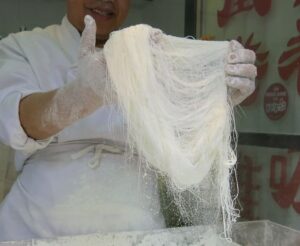
Dragon’s Beard Candy, also known as “Chinese Cotton Candy,” is a prime example of the masterful blending of culinary creativity and traditional culture. This delicate confection, which has its origins in ancient Asian traditions, has enthralled generations with its elaborate preparation and distinctive texture, which is reminiscent of fine silk threads. In this essay, we will explore the origins, preparation, and cultural significance of Dragon’s Beard Candy, shedding light on the science and craftsmanship behind this time-honored treat.
Dragon’s Beard Candy has a rich history dating back to ancient China, where it was once considered a delicacy reserved for royalty. The candy’s creation takes on a mythical charm due to its association with dragons, which are highly revered in Chinese mythology. Dragon’s Beard Candy is a popular treat at weddings, festivals, and other special occasions. It has evolved over the centuries into a symbol of joy and celebration.
The fundamental ingredients for Dragon’s Beard Candy are simple yet essential: sugar syrup and starch. First, a viscous syrup is made by heating sugar and water together. The critical step lies in the meticulous pulling, twisting, and folding of the sugar strands. This intricate dance transforms the once-solidified syrup into countless fine threads, resembling the beard of a dragon. There are two benefits to adding cornstarch or potato starch. First of all, it keeps the delicate strands from adhering to one another, preserving the candy’s unique texture. Second, the starch enhances the entire sensory experience by subtly counterbalancing the sweetness.
There is an intriguing interaction between physics and chemistry in the making of Dragon’s Beard Candy. The process of pulling sugar is similar to an alchemical cooking technique in which heat and constant stretching turns sugar syrup into an intricate web of tiny threads. In addition to adding layers and air to the candy, twisting and folding gives it a fluffy, dreamy texture. The structural integrity of the candy is enhanced by the starch coating. Starch is essential for preserving the uniqueness of each sugar strand by preventing them from combining or collapsing thanks to the processes of encapsulation and absorption.
Crafting Dragon’s Beard Candy requires a delicate touch and a keen understanding of the candy’s behavior under various conditions. Skilled confectioners become experts at pulling sugar, measuring syrup consistency, and striking the ideal ratio of elasticity to fragility. With meticulous execution of every twist and fold, the confection is not only aesthetically magnificent but also a demonstration of the artist’s talent.

The manual way of stretching the candy is by hooking and folding it over itself, which involves a multiplication factor of 2 (doubling in length). Nowadays, the modern candy-pulling machine implements a stretch factor related to the Golden Ratio,(1/2 + sqrt(5)/2 approximately 1.618), which is based on the number of rods/hooking with in the machine. The Greek letter phi (φ), which represents the mathematical constant known as the golden ratio, has historically been used to symbolize harmony and proportion in art. Within the culinary arts, Dragon’s Beard Candy presents an interesting pairing for the golden ratio as delicate dance of precision and ratios goes into the painstaking preparation of this old confection. The intricate texture of the candy is achieved by pulling, twisting, and folding the sugar strands, which demonstrates a meticulous attention to proportions and is reminiscent of the influence of the golden ratio in both art and nature. The golden ratio is subtly acknowledged as one savors the dreamy sweetness of Dragon’s Beard Candy, linking the culinary experience to the timeless appeal of mathematical beauty.
Dragon’s Beard Candy is more than just candies; it is a culinary masterwork and a cultural asset. Its preparation, which has its roots in antiquated customs, accentuates the tasteful fusion of science and artistry. Savoring the threads of this delicious treat allows us to participate in a timeless tradition that weaves us into the rich fabric of cultural celebration and culinary history. Dragon’s Beard Candy encourages us to recognize the beauty in the craft of people who, akin to contemporary alchemists, turn ordinary ingredients into sensory-pleasing wonders.
Sources:
Cyeeahn. “Dragon’s Beard Candy.” Red Thread Kitchen, 29 Jan. 2021, www.red-thread-kitchen.com/post/dragon-s-beard-candy.
“Dragon’s Beard Candy – Alchetron, the Free Social Encyclopedia.” Alchetron.Com, 7 Sept. 2022, alchetron.com/Dragon%27s-beard-candy.
Ellenberg, Jordan. “The Number That Becomes More Amazing the More You Study It.” Slate Magazine, Slate, 8 June 2021, slate.com/technology/2021/06/golden-ratio-phi-irrational-number-ellenberg-shape.html.
Lugonja, Valerie. “Dragon Beard Candy.” A Canadian Foodie, 5 May 2015, www.acanadianfoodie.com/2015/05/05/dragon-beard-candy/.
Magazine, Smithsonian. “Using Math to Build the Ultimate Taffy Machine.” Smithsonian.Com, Smithsonian Institution, 21 Oct. 2016, www.smithsonianmag.com/science-nature/using-math-build-ultimate-taffy-machine-180960849/.
The Mathematics of Ta y Pulling – University of Wisconsin, people.math.wisc.edu/~thiffeault/talks/ddays2018.pdf. Accessed 14 Dec. 2023.

